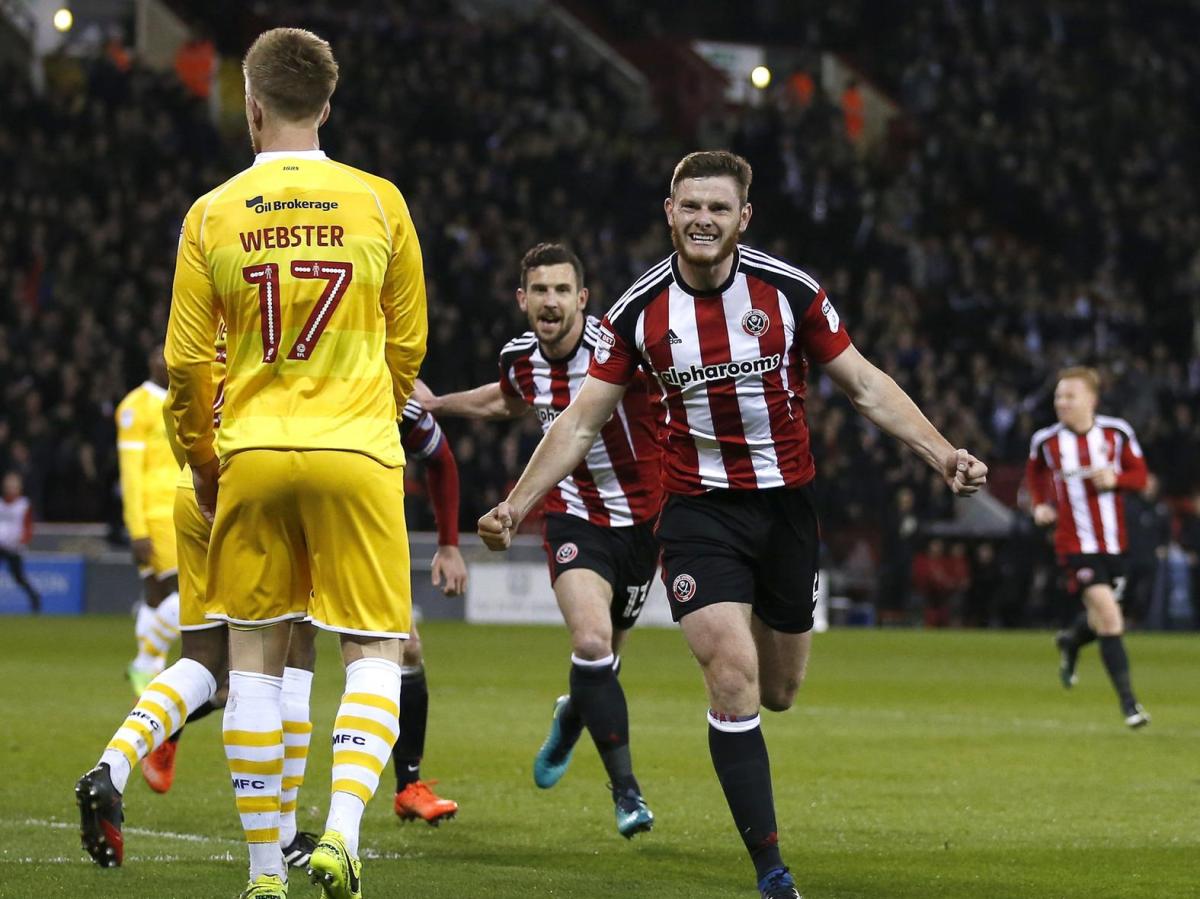Sheffield United are arguably the club with the most upward momentum in the entire country at the moment. After a wobbly start last season, they eventually steamrollered through League One, finishing as champions with l00 points on the board. They now sit 3rd in the Championship and continue to pick up points at the same rate as they did in League One – kind of absurd when you think about it – with Chris Wilder, the manager, and Alan Knill, Wilder’s assistant, rightly getting plenty of plaudits for this period of success as the Blades look fearless in their bid to complete their ascendancy back into the Premier League.
It’s rare a team coming out of League One adapts to the Championship with the ease that Sheffield United have and many people wonder quite how Wilder’s managed it. I’ve been lucky enough to watch them a couple of times this season and, tactically, they’re genuinely a really interesting team to watch – setting up in a 3-5-2 and pretty consistent with their attack-minded, high-energy, high-pressing approach, always playing on the front foot. Probably their most interesting tactical quirk is the occasional use of overlapping centre backs to provide an overload on the wing.
That’s a little gem for you to go and discover for yourself though as, in this article, I’m going to put a certain aspect of their play under the microscope, another aspect of their play I think they’re doing very successfully – set pieces. To add a bit of colour to this, I’ll first provide you with a quick bit of background on how Wilder & Knill initially grabbed my attention about two years ago now.
Part 1: The Back Story
To be honest, this part isn’t an obligatory read and you can skip down to Part 2 if you’re in the mood already and just want to see the analysis of Sheffield United. It’s not advised though – this is a good primer to get those juices flowing.
The Date: December 12th 2015. The Match: Luton Town vs Northampton Town.
Many of you won’t be aware that I’m a Luton fan first and foremost. On the date mentioned, I found myself in the stands and enjoying Luton’s game against Northampton who had started the season very well – joint-top of the League Two table at the time this match was played – and who were then managed by a certain Chris Wilder and Alan Knill. Who’d have thought. Luton took an early lead in the 9th minute before this happened in the 18th…
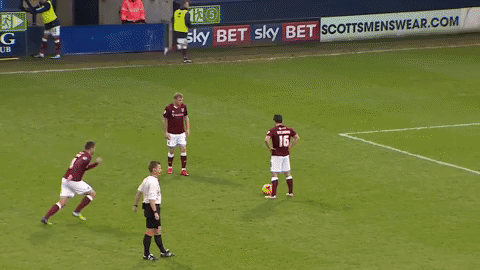
Probably the best set piece routine I’ve ever seen in the flesh. Our defence was pretty clueless that season but, in fairness to them, I think this routine would’ve had even the wiliest of old-school Italian defences chasing shadows.
***Fast forward to the following season – 2016/2017.***
The Date: 24th September 2016. The Match: Scunthorpe United vs Sheffield United
To quickly fill you in on what occured for Wilder & Knill between the 12th December 2015 and 24th September 2016, Northampton went on to win 99 points and the League Two Title prompting Wilder’s boyhood club Sheffield United to come calling for his services, which Wilder enthusiastically accepted.
I wasn’t in attendance at the match this time, but rather sat on my sofa watching the highlights of the EFL goals the following morning. I do have a strong interest in all the goings on from the Championship down to League Two, but a match-up between Scunthorpe and Sheffield United was fairly unremarkable to me until this happened…
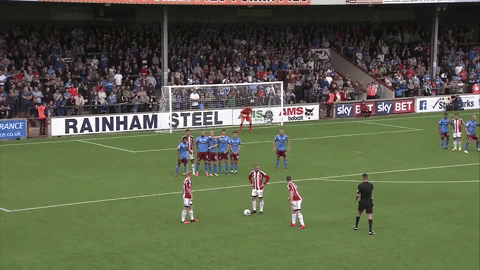
Honestly, if I was impressed the first time, I was doubly so the 2nd time as I realised that Wilder & Knill (and I’m led to believe it’s mostly Knill) take their set pieces seriously. Anyone who can turn a regular, edge-of-the-box free kick situation into a one on one with the keeper has my attention. And with my attention held, this next match then happened…
The Date: 26th November 2016. The Match: Charlton Athletic vs Sheffield United
Slightly further into the 16/17 season, I’m in attendance at this match for work reasons and looking forward to watching a Sheffield United side who were looking like they might finally break out of League One after 5 years of failing to do so and underperformance on their budget and expectations. The away side take the lead with this:
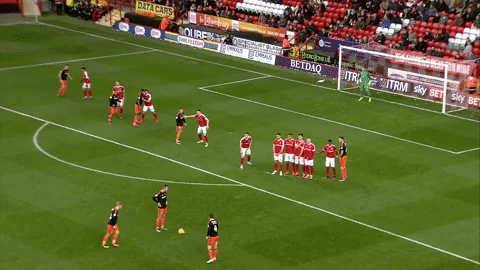
There’s question marks over the goalkeeping, sure, but again it’s obvious this was another routine that had another defence dumbfounded and frozen in the headlights. Charlton’s defence didn’t know what to do once Mark Duffy makes his run into the right channel (aided by some clever blocking by Chris Basham #6). Even if Duffy doesn’t shoot, they’ve still managed to create a dangerous cut-back situation from a free kick many teams would opt to directly shoot from (only resulting in a goal ~5% of the time).
The rest, as they say, is history. Wilder took Sheffield United to the League One title (a 2nd successive title for him) with 100 points on the clock.
So now you have the backstory, you can better understand my motivation for taking a look at how Sheffield United have been getting on with set pieces this season, especially given the way they’ve started this season as Mr Midas-Touch himself (Wilder, as if I really needed to clarify) leads them to what’s looking like another successful campaign.
To get a general overview of how Sheffield United have been performing on set plays this season, we’re going to look at what the data says about their set pieces first, kindly provided by Stratagem. This will be a brief but important overview, shaping the rest of the piece.
If you’re unfamiliar with the concept of Expected Goals/Chance Quality – give the paragraph below a quick read. If you’re comfortable with the idea, carry on.
Expected Goals (xG) is simply a method used to quantify the quality of chances created and conceded by a team throughout a game. It is calculated by taking a shot and looking at historical data (collected by companies such as my employer, Stratagem) to calculate the conversion percentage of shots from the past that had the same characteristics as the new shot. The basic theory is that 1) the closer the shot is to goal, the more likely it’ll go in, 2) a shot from a central location is more dangerous than a shot from a wide location, and 3) shots with feet are more dangerous than headers from the same distance. As an example, imagine Harry Kane has a header on goal from just outside the 6 yard box following a cross from Danny Rose. You’d look back at all headers from just outside the 6 yard box following a cross, to find it has a conversion percentage of 15%*. This would give Harry Kane’s header an Expected Goal value of 0.15. If you’d like to read more about why Expected Goals is useful information for teams and players, I recommend giving this by @OneShortCorner a read as it explains in simple terms what xG’s useful for and how to interpret it.
*I pulled this number out of thin air.
Let’s get going.
Part 2: The Data
To frame their season so far, Sheffield United have accrued 36 points from 18 games, putting them 3rd in the Championship table. For what it’s worth, I’ve also got them rated 3rd in my expected goals model generated from the Stratagem data, so they’ve been broadly getting the results they deserve so far and are already an elite Championship team.
As stated though, we’re focusing on set pieces so lets look at how The Championship looks in attacking set piece performance – the data is filtered to include only chances created from corners and free kicks (so doesn’t include direct free kick shots).
First up, the total chances created from set pieces this season.
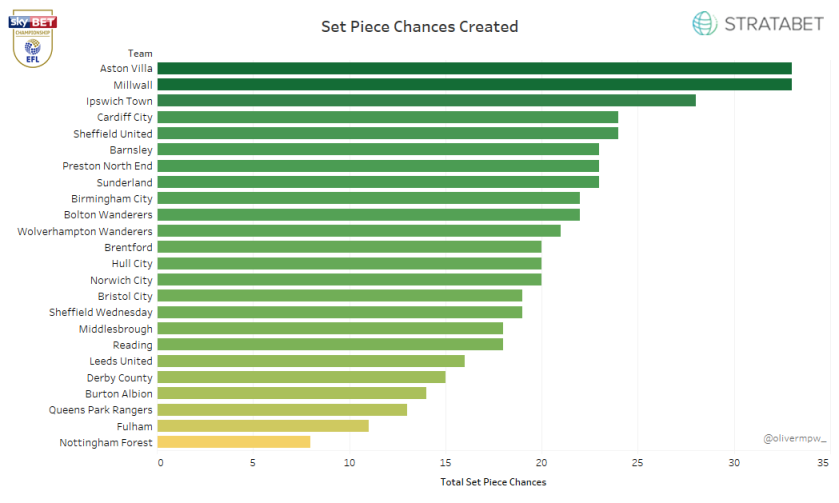
The Blades are sitting pretty in joint-4th for most chances from set plays this season with 24 chances created. So we can already see they’ve been active in that respect, as expected.
It’s a good trait to be creating a large number of opportunities from set plays, but what about the quality of chances created from those plays?
Here’s the total xG created from set piece situations.
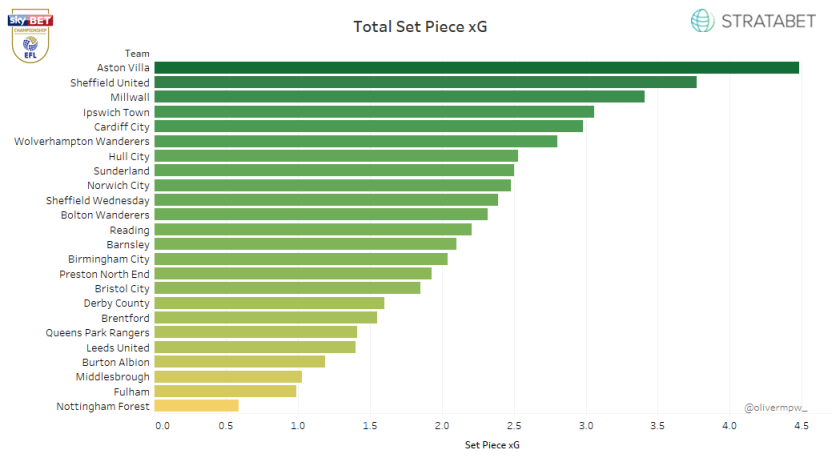
Again the Blades are stacking up well here, ranking 2nd in expected goals created from set plays.
Lastly, just for further illustration, we want to know how the Blades shape up when looking at who’s the best at creating high quality chances on average from set plays, done by dividing the Total Set Piece xG by the Total Set piece chances created.
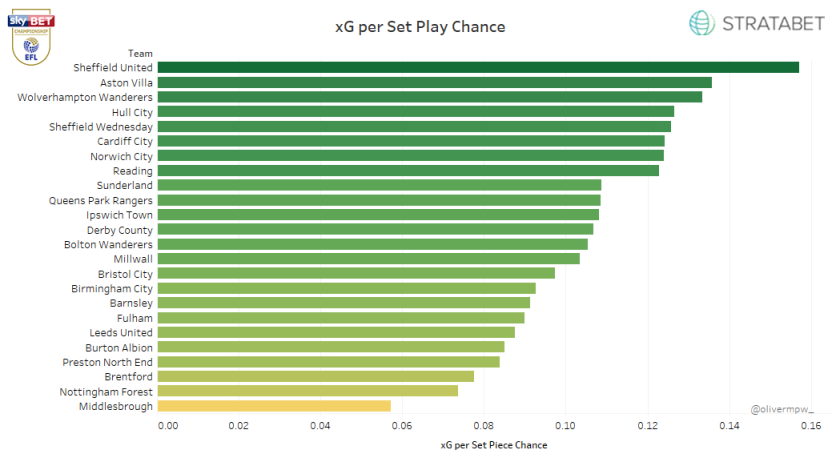
I suspected this might be the case having watched A LOT of Sheffield United set piece video over the last couple of days (oh, trust me, you’ll be hearing more on this). Of the chances that the Blades have created, the average quality of them is higher than the rest of the league and reflects the thesis that they know how to create a good chance from a set piece.
*Disclaimer: Take all these numbers with a pinch of salt. The season is fairly young and the number of chances fairly small, so some of this may be down to accident rather than design. But there’s enough to go on to tell a story so lets do just that*
Juuuuuust before we move on to the good part, we want to know which players have been the most dangerous outlet for Sheffield United. We’re going to be focusing on one guy and here’s the reason why:
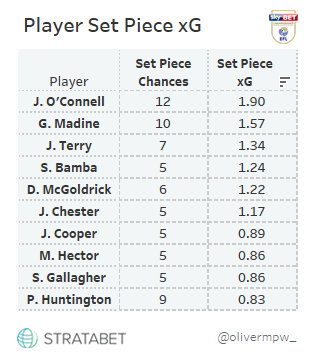
Meet Jack O’Connell. Or Jack O’Cornerll as you may as well start calling him. I stopped short of titling this piece “The Jack O’Cornerll Story” because there’s plenty of other facets to Sheffield United’s set plays that make them so effective, not just O’Connell. But, the point is, I could well have done. The League leader in xG’s from set pieces, the boy is a set-piece magnet/pain in the backside for defences as we’re about to see.
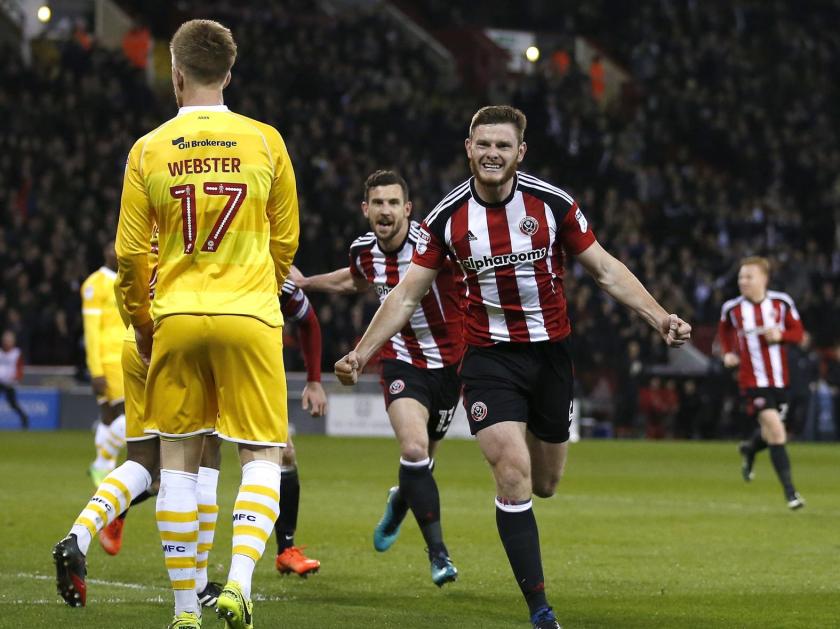
12 chances may seem like a low number but the data will only account for occasions when O’Connell has got a shot off (or has come very close to getting one off as we do collect that data too). It won’t include times when he’s played knock down’s for other players, or has made an excellent run but hasn’t been rewarded with a quality of delivery that means he’s able to get an attempt on goal.
But as any Real Football Man™ will tell you, football isn’t played on spreadsheets, it’s played on the pitch. So your reward for making it this far is that you now get to watch more video of what Sheffield United have come up with this season and why they’re one of the most dangerous teams in the Championship from these situations.
Part 3: The Video
So for this section we’re going to look at Corners and Free Kicks separately and look at the trends for each to see if we can pick up on what Sheffield United are doing that’s generating their set piece threat. Corners first.
Corners
I should point out now that I’m using data up to 20th November as that matches the data I have available for the Expected Goals graphics above – so Sheffield United have played 17 games in the dataset I have available. They’ve had 114 corners in this time and, because I’m too good to you, dear Reader, I’ve watched every single one of these in video and collected some basic information about the delivery of the corners to try and break down what Sheffield United are trying to do and discover any trends.
To give you some initial primers on what you’re about to watch:
-Sheffield United have 2 main corner takers: John Fleck (49 taken) and Paul Coutts (40 taken).
-70% of their corners are in-swinging – a clear strategic decision.
– Of their 114 corners, 21 have directly led to a shot (18%) but with several others going close to creating dangerous situations, as you will see.
-Their split between different Areas of Delivery is fairly even: Near Post (24% of deliveries), Far Post (32%), Centre (area between the goal posts – 21%) and Short corner (23%)
-However, Far Post Corners account for 61% of their total corner chances, and 54% of their xG created from corners. It’s clear that Far Post corners are their strength so we’re going to look at those particularly closely. As you’ll see with the upcoming analysis, The Blades are reeeeally good at creating far post opportunities.
The Headline Routine – The Bear Hug Block
I’m just going to dive in head first here and start off with my favourite corner hack I’ve seen possibly ever? Not because of the great chance created, but because of how it’s created. In their recent fixture vs QPR, United manage to create a humongous space at the far post and there’s a few things to break down here as to how they’ve managed to do it – it might require you watch the routine 10+ times but stay with me, it’s worth it when you can finally see all the moving parts and get a clear picture of what Wilder and Knill were aiming for on the training pitch.
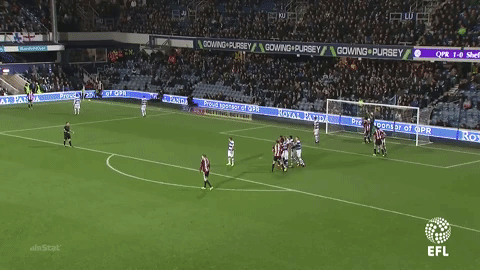
I’ll link to the video for those who want a clearer view. Click here.
- For starters, there’s an option for the short corner which drags two QPR bodies out of the box, leaving a 6v5 in QPR’s favour in the penalty area.
- Before the ball is played in, watch #6 Chris Basham in the far-centre of the 6 yard box. His run drags his marker towards the near post and away from the far post.
- Now, by the ‘keeper, watch Clayton Donaldson holding his marker down, preventing his marker from covering the far post delivery.
- One of 3 players starting near the penalty spot, watch Cameron Carter-Vickers make a darting run to the near post to take his marker with him.
Now we know how the space at the far post is created. But how is it expolited?
- Cast your attention to the gathering on the penalty spot at the start of the delivery. This is where Jack O’Connell and partner-in-set-piece-menace Leon Clarke start, with Carter-Vickers.
- As soon as Coutts, taking the corner, drops his arm, just watch Clarke. He grabs O’Connell’s marker into a bear hug leaving the marker no chance of tracking O’Connell.
Voila. It’s so damn smart, but somehow O’Connell fails to hit the target. They even tried it again in the same game a few minutes later with O’Connell and Clarke swapping roles. This time O’Connell’s marker is wise to the routine and follows the ball whereas Clarke’s marker manages to follow him literally by grabbing a handful of his shirt and clinging on for dear life.
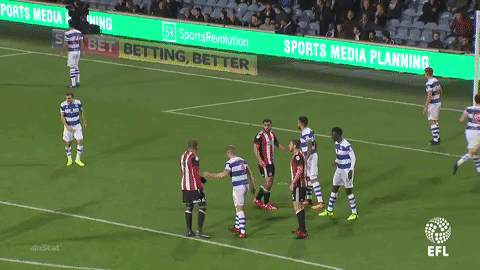
They’d tried this one in the previous fixture vs Leeds too, though the execution was let down by a poor delivery from Mark Duffy this time. But O’Connell was there and free at the far post again and it’s hard to imagine him not getting a goal from this exact method at some point during the season should teams not wise up to it.
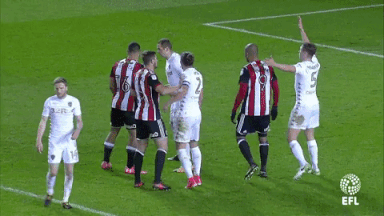
The Trends
So that was the headline routine which is by far their most dangerous. There’s two main trends I’ve observed from Sheffield United’s other corner’s and how they look to create the space to attack.
1) Blocking.
In case I haven’t made it clear enough, O’Connell is Sheffield United’s biggest set piece threat and that’s very much intentional. Most of their routines are set up to get him on the end of them as seen above and in further examples below. This video is from their match vs Barnsley and, although the video isn’t ideal to show it, you can still see how blocking has created the chance for O’Connell here. Blocking appears to be Sheffield United’s main strategy of creating chances vs man-marking set ups.
- O’Connell is the player near the edge of the box at the start of the video, with Jake Wright the closest Sheffield United player to him. Both are clearly marked by Barnsley players.
- Whilst the video is zoomed in on John Fleck taking the corner, Wright steps across O’Connell’s marker to delay his run by that fraction of a second needed to create enough space for O’Connell to win the header and have a decent attempt on goal. You can just about see this as the camera reverts back to the standard TV angle.
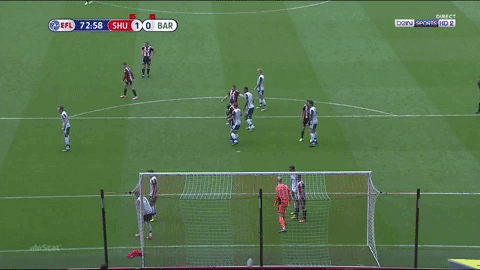
And now a slightly different version of the routine here but that still reinforces the point, vs Hull.
For starters, this time it’s a near-post run. Keep your eye on the bottom right of the video as Duffy prepares to take the corner. Carter-Vickers is clearly watching and waiting for O’Connell to make his run before making that trademark step across the defender. Football is a game of fine margins and what finer margin than half a second gained on your defender which allows a free header at goal.
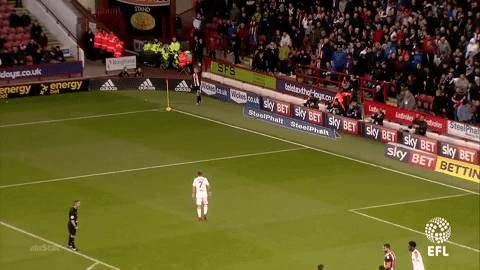
2) Using runners to create space at the far post.
It’s a point I mentioned earlier, Sheffield United are great at using runners to create space for O’Connell to attack. In this one, vs Ipswich, Sheffield United start off with 5 men in the penalty area – 3 in the 6 yard box, 2 in formation near the penalty spot. Starting from the 6 yard box, Leon Clarke and Chris Basham make runs towards the near post taking 4 Ipswich defenders with them.
Thanks to these runs, this leaves O’Connell, starting at the top of the penalty area, with a one on one in which he is always likely to win.
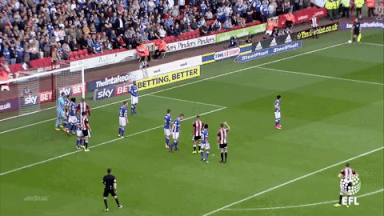
All the examples we’ve seen so far have been broadly man-marking set ups, so how do they fare against zonal marking?
3) Zonal Marking
I couldn’t find too many clips to actually give this question a good answer, but this vs Norwich is probably the best example.
Norwich line up with a 7 man defence on the edge of the 6 yard area, also placing 1 man on the far post.
Sheffield United’s answer to this one is simple (and heartwarmingly predictable now): Block the far side defender and allow Jack O’Connell a free header of the ball. You can see Jake Wright get into position to block Cameron Jerome (#10) and make sure Jerome isn’t able to make any movement towards the ball.
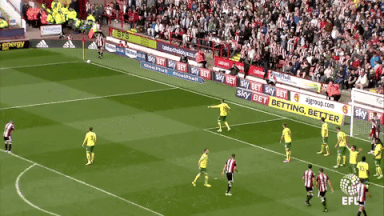
That just about covers all my observations on the Blades’ corners. But, as you saw at the start of the piece, Wilder & Knill are savvy at free kick set ups too – so what about those?
Wide Free Kicks
I’ve defined wide free kicks as any dead ball taken from an area outside the width of the penalty area. I’m also going to break these up further into, for want of better phrases, “Deep” Wide Free Kicks and “Shallow” Wide Free Kicks. Deep Wide FK’s are free kicks taken before the 18 yard line, with Shallow Wide FK’s taken beyond the 18 yard line. This may seem odd but there’s a reason why I’ve made that distinction which we’ll discuss shortly. Let’s start with Shallow Wide Free Kicks.
Shallow Wide Free Kick’s
I’ll whizz through these in order to get to the Direct Free Kicks where there’s a bit more action to speak of, but this piece is all about Sheffield United’s set piece trends and one thing I’ve noticed is the differentiation between these Shallow WFK’s and Deep WFK’s. Shallow WFK’s are almost always taken with an in-swing, much like their corners are. This seems smart as, with less of a gap between the defensive line and the goalkeeper, there is little space for any attackers to run in to, so an in-swinging free kick makes up for the lack of running space by allowing the striker to use the movement of the ball to guide it towards goal rather than trying to change the direction of the ball like they would have to if the free kick was out-swinging. By the same token, it’s slightly harder for defenders as they have to be more precise about any clearances they attempt with the ball moving towards their goal rather than away from it.
Two examples are this vs Cardiff:
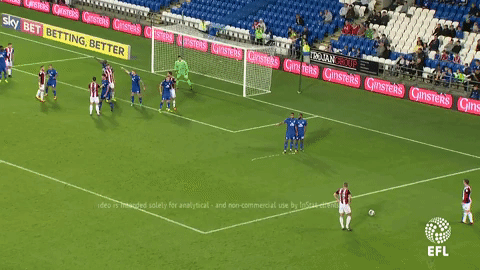
And this vs Middlesbrough:
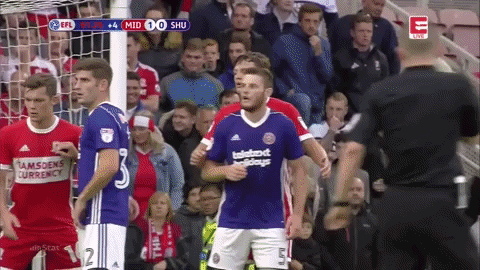
Deep Wide Free Kicks
On the contrary to what I wrote for Shallow WFK’s, Sheffield United show a preference for out-swinging free kicks when taking from deeper wide positions. With these, there’s a large space between the defensive line and the goalkeeper so the attacking players will now have more room in which to attack the ball. With an out-swing, this leaves little chance of the goalkeeper coming to intercept the ball which, if executed correctly, leaves the Sheffield United attacker in a one-on-one duel with his defender.
Leon Clarke showed a good execution of a typical Sheffield United Deep Wide Free Kick vs Wolves, sticking to his man and using the pace of the ball to head it back across goal:
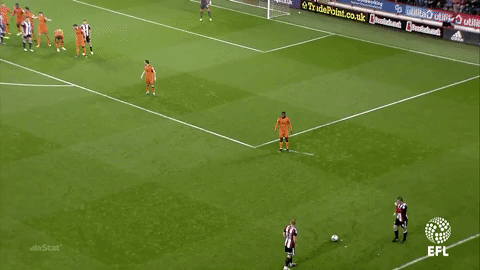
This next one is slightly different as it looks more like it’s just down to the improvisation and excellent communication of Fleck, delivering, and Billy Sharp, receiving, but my hunch is that the look they share between them is an indication that this was pre-meditated. Just watch how Sharp appears to be jogging back into position but gets Fleck’s attention and they share a look before Sharp spins off the defence.
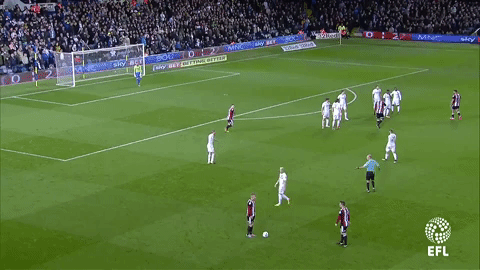
We’re nearly done, just one more aspect of Sheffield United’s set piece play that we need to look at: free kicks from (typically) Direct situations.
Direct Free Kicks
It’s only fair that we give those two crafty free kick routines that were seen at the beginning of the piece the once over in the same way we’ve looked at every other set piece situation. Particularly as The Blades have actually attempted both routines this season, showing they’re very much still a part of the playbook.
Now I can only speculate but it seems Wilder has a bet on O’Connell to be Championship top scorer because he really does seem intent on having the man on the receiving end of every set piece. This is vs Reading.
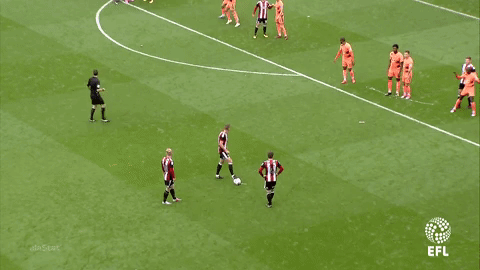
I’ve said this already but I really do love this routine simply because when it works, it turns a poor goal-scoring chance into a great goal-scoring chance. This one didn’t come off quite as well because Chris Gunter reads the situation and is able to get across to block despite Mo Barrow’s questionable decision to just let O’Connell have the freedom of Bramall Lane. I’m actually going to break the routine down using the successful version seen earlier as it’s much cleaner and easier to break down the moving parts.
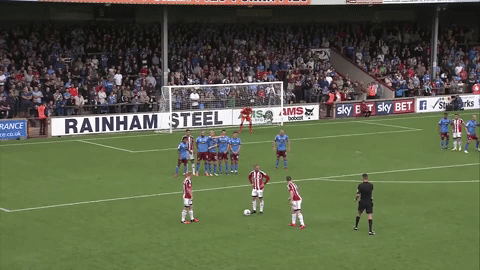
I’m aware this is like a potato-print painter trying to describe the works of Van Gogh, but this potato-printer has studied the Van Gogh painting enough times to know what’s going on.
-First up, make a mental note of goalscorer Chris Basham’s starting position, stood as part of the wall.
-Next, examine the role of the player who first runs over the ball. This is John Fleck – without this run the goal couldn’t happen. What he does is drag the only Scunthorpe defender who *might* just track Basham’s run away from the wall, thus taking him away from Basham.
-The wall itself is completely focused on blocking the expected shot, and are then caught unaware when the ball is passed to you-know-who Jack O’Connell.
-Basham has already pulled away from the wall by this time and the first time pass from O’Connell leaves Basham with the relatively simple task of finishing past the keeper.
I mean it’s just so good, isn’t it?
And now for the other routine, seen here in action this season vs Nottingham Forest:
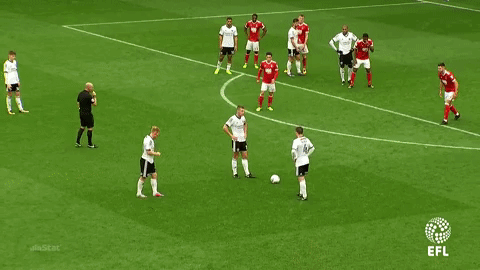
No goal this time and probably not as pretty as the previous masterpiece but, as you can see, a cutback is arguably a more favourable position to be than taking a cross from the free kick starting point, thus making it a +EV move. Even though it didn’t come off, the point of why Wilder & Knill dream up these routines is an important one which I’ll try and summarise below.
Closing Thoughts
What you want to try to do with all set pieces, through any method, is to create the optimum possible goal-scoring opportunity from the situation.
I think we can all see now that that’s exactly what Chris Wilder & Alan Knill are doing.
Fin.
Twitter: @olivermpw_
P.S
If you enjoyed this article and want to see more coverage of set pieces and routines in particular then I implore/urge/demand you check out Stuart Reid’s work (@From_the_wing). His work on set-pieces is largely what inspired me to churn this piece out and given that he currently works with professional clubs on their set piece execution, it’s best you read all while you can before he signs an NDA and stops sharing the good work with us.
https://www.esdfanalysis.com/author/stuart-reid/
This article was written with the aid of StrataData, which is property of Stratagem Technologies. StrataData powers the StrataBet Sports Trading Platform, in addition to StrataBet Premium Recommendations.

